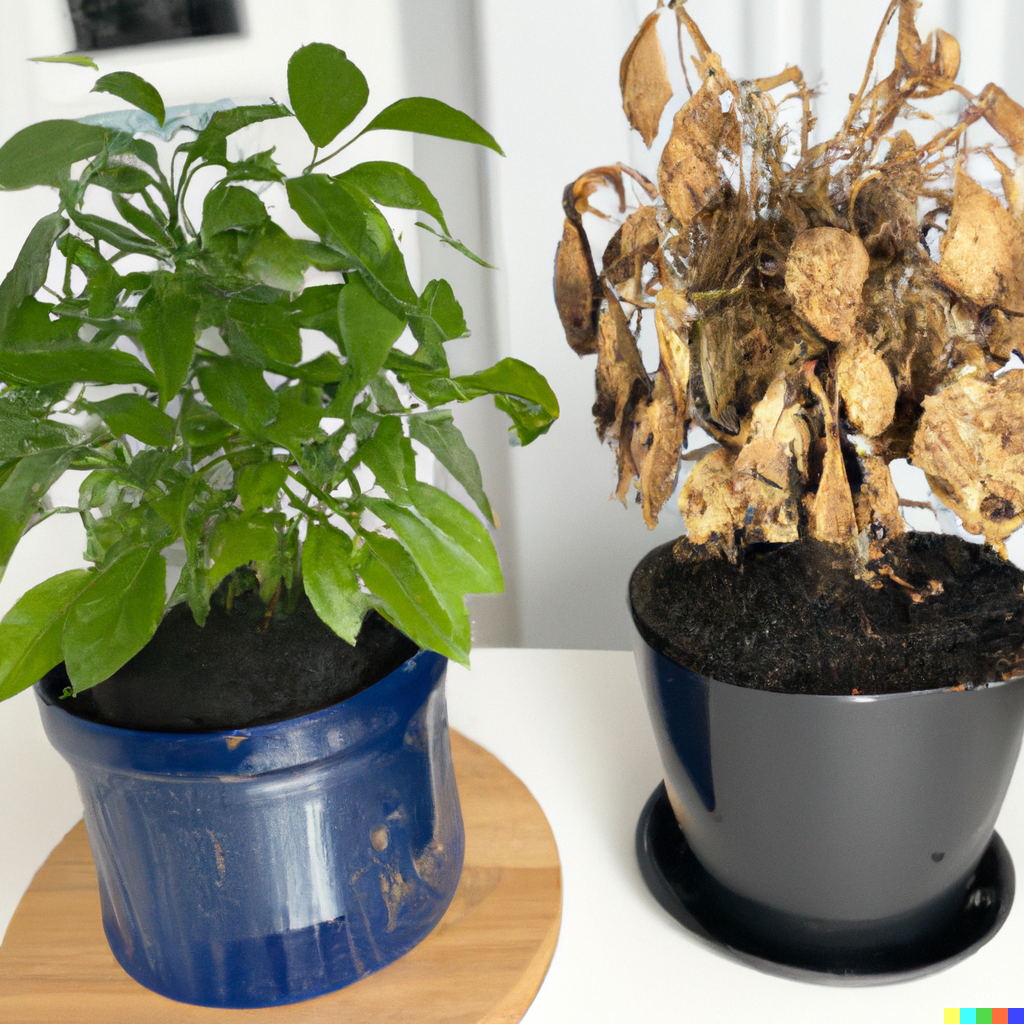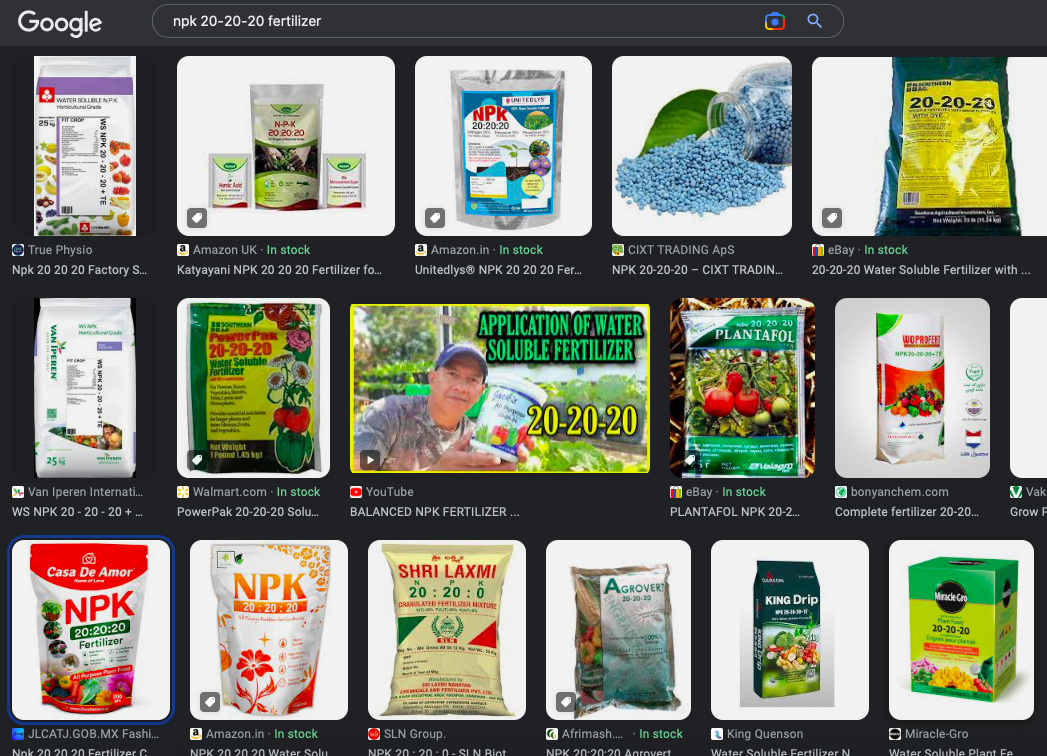A Beginner's Guide to NPK 20-20-20 Fertilizer: What You Need to Know
NPK 20-20-20 is a type of fertilizer that contains equal amounts of the three primary nutrients that plants need to grow and thrive: nitrogen (N), phosphorus (P), and potassium (K).

NPK 20-20-20 fertilizers are generally considered to be a "balanced" fertilizer, as they provide a good balance of the three primary nutrients that plants need. They are often used to provide a general-purpose fertilization for a wide range of plants, and can be used to support the growth and development of flowers, vegetables, herbs, and other types of plants.
The three letters in NPK stand for:
- Nitrogen: which is important for producing chlorophyll, which helps plants make food through photosynthesis.
- Phosphorus : which helps plants grow new cells and tissue, and break down proteins for energy.
- Potassium : Which helps regulate food, water, oxygen, and carbon dioxide in plants and makes them stronger. It also helps protect plants against pests, diseases, and adverse conditions.
In this post, we'll explore what NPK 20-20-20 fertilizer is, how to use it, and some tips for getting the most out of this versatile plant food.
What does NPK 20-20-20 mean?
NPK 20-20-20 is a type of fertilizer that contains equal amounts of the three primary nutrients that plants need to grow and thrive: nitrogen (N), phosphorus (P), and potassium (K). These nutrients are typically expressed as a ratio, and in the case of NPK 20-20-20, it means that the fertilizer contains equal amounts of each nutrient.
For example, an NPK 20-20-20 fertilizer contains 20% nitrogen, 20% phosphorus, and 20% potassium. Whilst an NPK 10-10-10 contains 10% nitrogen, 10% phosphorus and 10% potassium.
Different plants have different nutrient requirements, so choosing the right NPK ratio is important for ensuring that your plants are getting the nutrients they need in the right proportions.
How does NPK impact plant growth?
Plants need a range of nutrients in order to grow and thrive, and these nutrients are not always available in sufficient quantities in the soil. NPK Fertilizers provide plants with the nutrients they need to grow and develop properly, helping to ensure that they have the nourishment they need to reach their full potential.
Without sufficient nutrients, plants may struggle to grow, produce flowers or fruit, or even survive. Using the right fertilizer can help to prevent nutrient deficiencies and promote healthy plant growth. Fertilizers can also help to improve the overall health and vigor of plants, making them more resistant to pests and diseases.
It's important to note that using too much or the wrong type of fertilizer can also be harmful to plants. Overfertilization can lead to problems such as leaf burn or root rot, so it is important to follow the instructions on the fertilizer label and use the recommended dosage and frequency of application.
By using fertilizers responsibly, you can help to support the healthy growth of your plants and ensure that they have the nutrients they need to thrive

Can plants grow without NPK?
Plants do require certain nutrients to grow and thrive, and nitrogen (N), phosphorus (P), and potassium (K) are three of the most important macronutrients that plants need in relatively large amounts.
That being said, it is possible for plants to grow without NPK fertilizers, provided that they are able to obtain the necessary nutrients from other sources. For example, plants can obtain N, P, and K from the soil itself, either through the breakdown of organic matter or through the addition of organic fertilizers such as compost or manure.
Some plants may also be able to obtain these nutrients through symbiotic relationships with microbes or other organisms, such as nitrogen-fixing bacteria that are able to convert atmospheric nitrogen into a form that plants can use.
Aquarium water can also be used to provide plants with some of the nutrients they need to grow. Aquarium water contains a variety of nutrients, including N, P, and K, that are produced by the fish, plants, and other organisms living in the aquarium. When the water is changed, these nutrients can be collected and used to fertilize plants.
Can we apply NPK directly to soil?
So you might be wondering if you can just sprinkle some NPK fertilizer directly onto your soil and call it a day. Well, the short answer is yes, you can technically do that. But it's generally recommended to mix the fertilizer with water and apply it as a liquid solution instead. This helps the nutrients get absorbed more evenly by your plants.
To use NPK fertilizer directly on soil, just follow the application instructions on the product label. This usually involves spreading the fertilizer granules evenly over the soil and watering it in to help dissolve and activate the nutrients.
Just be careful not to use too much, as overfertilization can actually harm your plants. And as always, it's a good idea to test the pH of your soil before applying any fertilizer to make sure it's in the right range for your plants.
How long does it take for NPK fertilizer to dissolve?
The amount of time it takes for NPK fertilizer to dissolve will depend on the specific product you are using, the size of the granules, and the temperature and pH of the water. In general, however, it should take only a few minutes for most NPK fertilizers to fully dissolve in water.
To dissolve NPK fertilizer in water, you will need to follow the appropriate mixing instructions for the specific product you are using. This typically involves adding the appropriate amount of water to a watering can or spray bottle and then slowly adding the NPK fertilizer, stirring or shaking well to ensure that it is fully dissolved.
If you are having difficulty getting the NPK fertilizer to dissolve, you may need to use warmer water or adjust the pH of the water to make it more alkaline or acidic. You can also try breaking up the fertilizer granules into smaller pieces or using a fertilizer spreader to help distribute the granules evenly in the water.
How do you mix NPK fertilizer with water?
To mix NPK fertilizer with water, you will need a watering can or spray bottle and the appropriate amount of water and NPK fertilizer based on the size of your garden or container and the specific needs of your plants. Here are the general steps to follow:
- Begin by reading the label on your NPK fertilizer product to familiarize yourself with the recommended application rates and any precautions or warnings.
- Determine the appropriate application rate for your plants based on the size of your garden or container and the specific needs of your plants.
- Fill a watering can or spray bottle with the appropriate amount of water based on the application rate you have chosen.
- Measure out the appropriate amount of NPK fertilizer based on the application rate you have chosen.
- Slowly add the fertilizer to the water, stirring or shaking well to ensure that it is fully dissolved.
- Once the fertilizer is fully mixed, you can apply it to your plants using a watering can, hose-end sprayer, or other suitable application method.
- Water your plants as usual, making sure to apply the fertilized water evenly to the root zone of your plants.
Which NPK ratio is best for plants?
There is no one "best" NPK ratio for all plants, as different plants have different nutrient requirements and may benefit from different ratios of nitrogen (N), phosphorus (P), and potassium (K). In general, however, a balanced NPK ratio of 20-20-20 (which contains equal amounts of N, P, and K) is a good choice for a wide range of plants and can provide them with the nutrients they need to grow and thrive.
That being said, there are some situations where a different NPK ratio may be more suitable for certain plants. For example:
- Leafy green vegetables, such as lettuce and spinach, tend to require higher levels of nitrogen for healthy vegetative growth. An NPK fertilizer with a higher nitrogen content, such as 30-10-10 or 40-10-10, may be more suitable for these types of plants.
- Flowering and fruiting plants, such as tomatoes and peppers, tend to require higher levels of phosphorus for healthy flower and fruit development. An NPK fertilizer with a higher phosphorus content, such as 10-30-10 or 10-40-10, may be more suitable for these types of plants.
- Root crops, such as carrots and potatoes, tend to require higher levels of potassium for healthy root development. An NPK fertilizer with a higher potassium content, such as 10-10-30 or 10-10-40, may be more suitable for these types of plants.
Ultimately, the best NPK ratio for your plants will depend on their specific nutrient requirements and the pH of your soil.
When should I use NPK 20-20-20 fertilizer?

The timing of when to use NPK 20-20-20 fertilizer will depend on the specific needs of your plants and the growing conditions in your garden or greenhouse.
In general, NPK 20-20-20 fertilizer can be used to provide a balanced supply of nutrients to plants during the vegetative growth stage, which is typically characterized by rapid stem and leaf development. This helps young plants that are just starting to establish themselves and established plants that are experiencing a flush of new growth.
You can also use the NPK ratio when you notice your plant is suffering from nutrient deficiencies. For example, a lack of nitrogen can cause yellowing leaves and slowed growth, while a deficiency in phosphorus can lead to stunted growth and brown spots on the leaves.
Does NPK affect pH?
NPK fertilizers generally do not have a significant effect on soil pH. The pH of soil is determined by the presence of certain minerals and the relative concentration of hydrogen ions, and it can be influenced by a variety of factors such as the type of soil, the presence of organic matter, and the acidity or alkalinity of the water used for irrigation.
There are other types of Fertilizers can affect soil PH. Ammonium-based fertilizers, which are commonly used in agriculture and horticulture, have the greatest potential to acidify soil due to the release of hydrogen ions as the ammonium is converted to nitrate. Nitrate-based fertilizers, on the other hand, have less capacity to acidify soil because they do not release as many hydrogen ions.
Similarly, compost, which is made from decomposed organic matter, has little effect on soil pH as it does not contain significant amounts of minerals that could alter the pH balance of the soil.
How does Banana peel Fertilizer compare to NPK fertilizer
Banana peels can be used as a natural source of nutrients for plants, as they contain a number of minerals and nutrients that can be beneficial for plant growth. Some of the nutrients that banana peels contain include potassium, phosphorus, calcium, and magnesium, as well as trace amounts of other minerals.
However, it's important to keep in mind that banana peels are not a complete fertilizer and should not be used as a replacement for a balanced fertilizer like NPK 20-20-20.
Some plant parents say they've never had problems with using banana peel fertilizers, so maybe it can be a replacement afterall. If you want to learn more about making your own banana peel fertilizer, check out our guide here
Conclusion
Among the many types of fertilizers available, NPK 20-20-20 fertilizer is a great choice for a wide range of plants, and it can be an especially useful option for beginner gardeners who are looking for an easy way to provide their plants with the nutrients they need.
By following the appropriate application instructions and being mindful of the recommended application rates, you can use NPK 20-20-20 fertilizer to support the healthy growth and development of your plants.